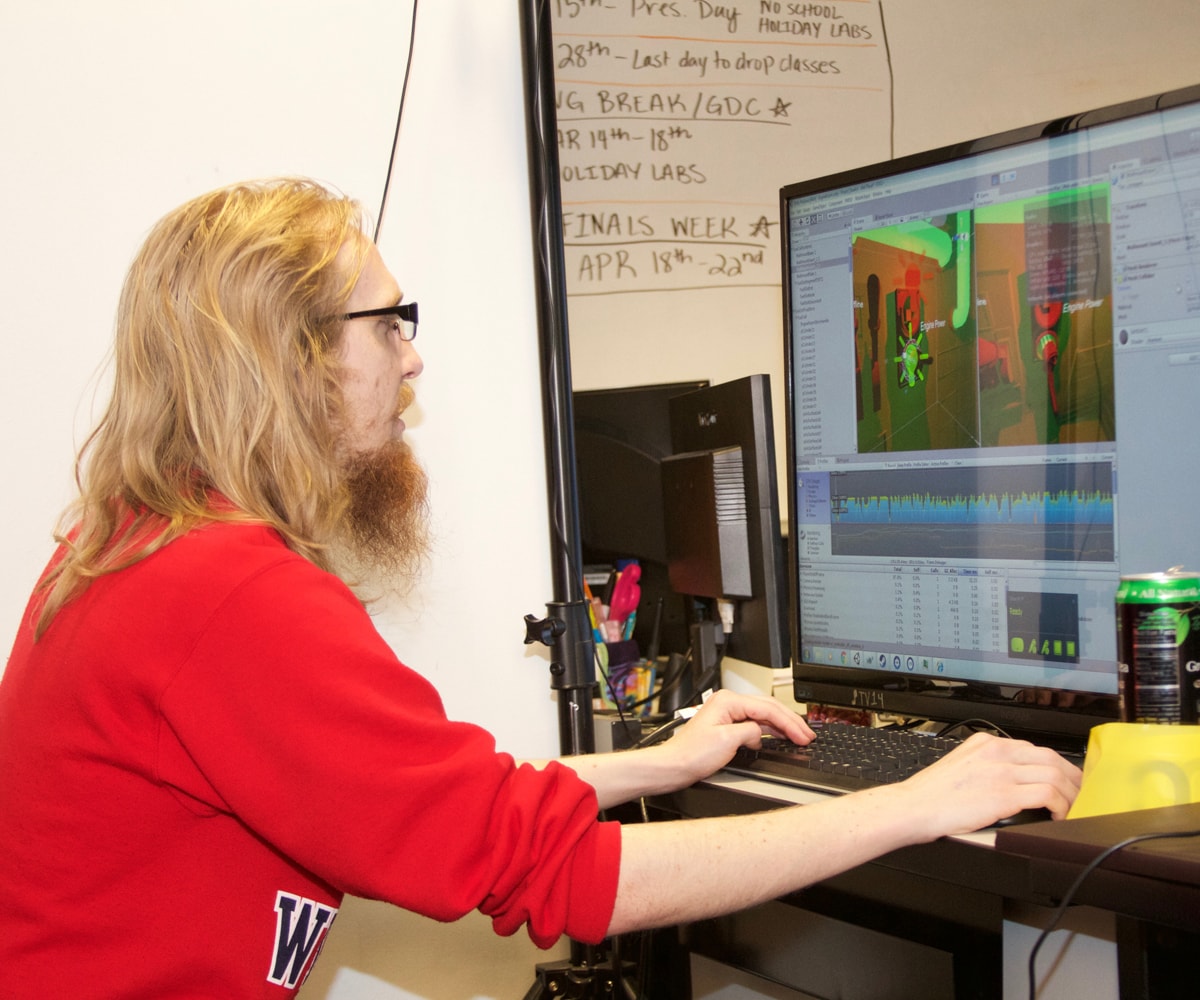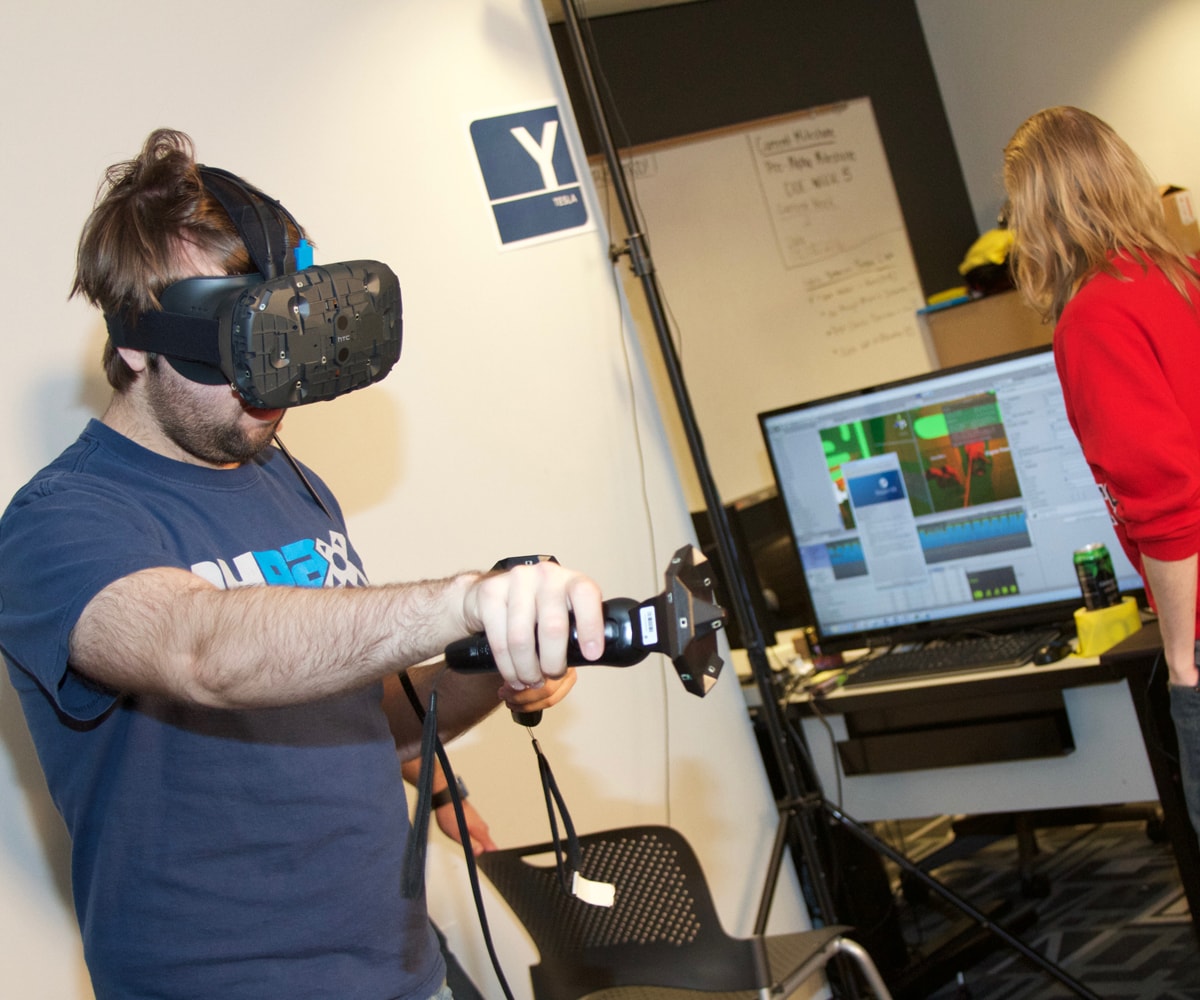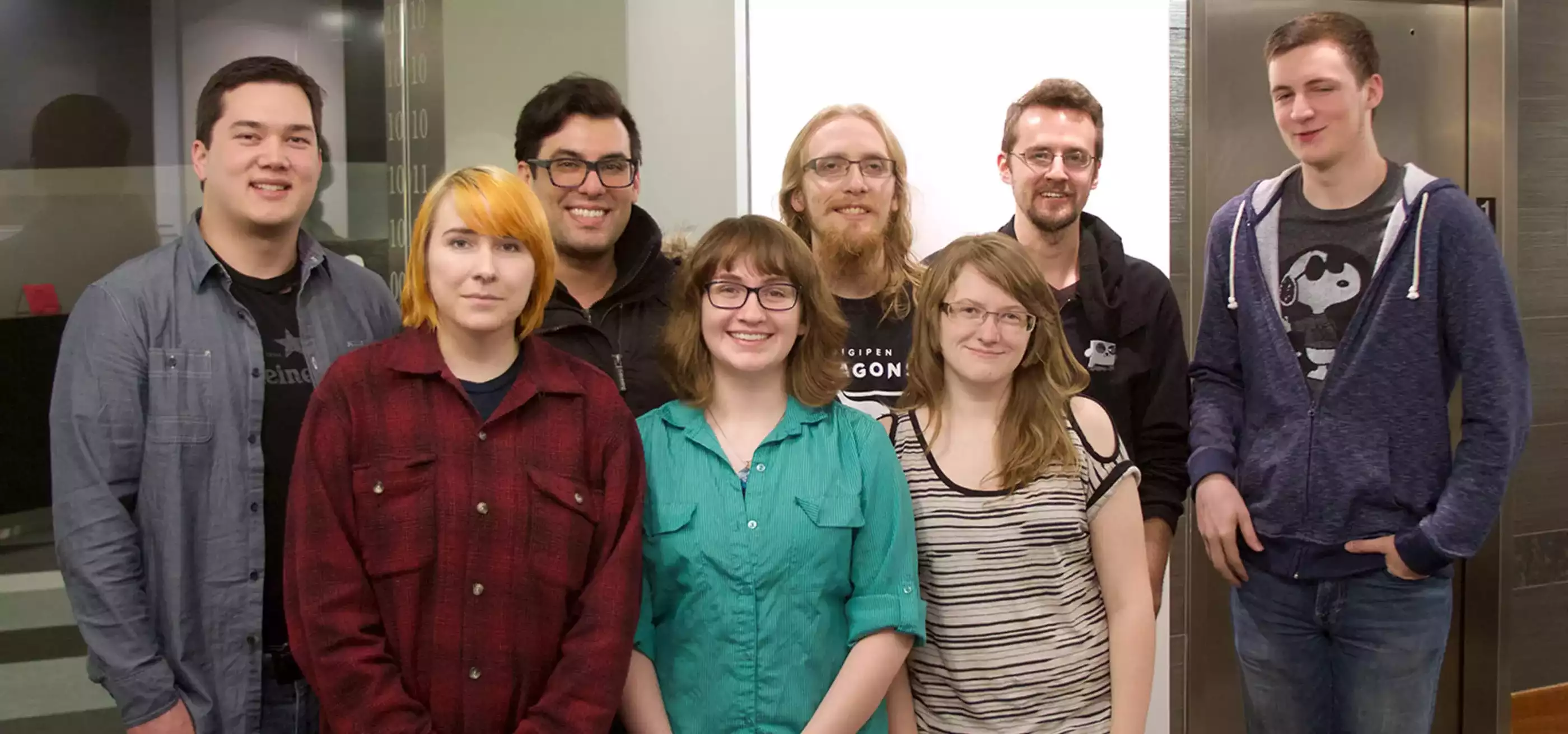“That feel alright?” says a disembodied voice. His hands adjust the straps and carefully move a tentacular power cord connected to a headset. The only thing in sight is white — white walls surrounding a white floor and white ceiling.
“It’s a little glitchy right now,” says another voice from outside the white. “You’re going to be in one of the rooms. You’ll be able to play with some stuff in there.”
And then: darkness. The white walls give way to swirling galaxies and constellations. These too disappear in a moment — where the dazzling night sky hung, computer-bedecked walls of aluminum and steel snap into place. Blinking electronic panels and mechanical instruments emit a gentle green light.
One step, then another — it’s important to test the floor, even though it’s really just carpet. To the right, over a metal handrail, a 50-foot-deep engine shaft reveals a layer of the spaceship’s underbelly. Seen through the porthole on the far end of the room, the infinite cosmos stretches out in all directions just beyond a thin layer of glass.
This is but a taste of Team Overboard’s mesmerizing virtual reality experience, Hereafter. The seven members of Team Overboard are all DigiPen students working with the Vive, a VR headset made by smartphone manufacturer HTC in collaboration with game studio Valve Corporation. This is each student’s first time working in VR.
When junior Bachelor of Arts in Game Design student Bryan Willy contacted Valve Corporation in early 2015 to see if he could get a prototype of the Vive, he already knew what kind of game he wanted to create in virtual reality.
“The initial idea for Hereafter was a very simple image that hit me, of just standing on a ship, looking out into space, contemplating your own mortality,” says Bryan. “I don’t know why that image resonated with me so strongly, but it did.”

After some back-and-forth that spanned upwards of six months, Valve sent Bryan a development model of the Vive so he could pursue his game idea. The headgear arrived late that summer, shortly before the beginning of Bryan’s third fall semester at DigiPen.
The Vive itself looks, at first, like other virtual reality headsets. To use the hardware, players strap a pair of screen-equipped goggles to their face while the computer projects images of another world directly before their eyes. Two controllers — roughly the size and shape of disassembled joysticks — act as surrogates for players’ hands while they’re in the false reality.
What makes the Vive different is that the system also tracks the player’s movements — not just where they’re facing, but also where they walk — within an adjustable play space. It does this via a pair of motion sensors set up in opposite corners of a designated space, which could be a room or a hallway or, as is the case for Team Overboard, in a remote corner of a computer lab.
Once he received the Vive, Bryan spread the word to attract other talented students interested in VR, and together they formed Team Overboard. The team aims to create a virtual reality game, which technical director Josh Louderback describes as “a very personal experience of being alone in space.”
“You’re trapped in space with a newfound AI, and it’s just you and them,” Josh explains. “We’re really just trying to face the player with ‘loss’ — putting the player in a situation where there’s no hope for them, but they don’t know it yet. [The game] gets them to that point.”
Bryan — the team’s creative director, gameplay dev, and narrative lead — points to sci-fi movies like Interstellar as an inspiration for Hereafter, but each student brings their own muses to the team.
“The way I pitch it to professional developers is ‘the one where you die at the end,’” says Kali Wakley, Team Overboard’s lead technical producer in technical and audio programmer. In addition to coordinating the technical pieces of the project and creating various elements like the introductory menu sequence, Kali works with the content creators to develop an immersive sound experience for Hereafter.
Each member of Team Overboard felt inspired to join the project for different reasons, though everyone agreed it was exciting to work on new technology.
“One of the big reasons I wanted to use [the Vive] was that it does a lot to immerse the player,” says Bryan. “We could just build a white-boxed room and put the players in with a headset, and they’d believe they’re there in a white-boxed room. All the work is done for you to make them feel like they’re there. And from there, you can make that space much more interesting, obviously.”

Treading uncharted waters hasn’t been easy, of course. Working with brand-new VR technology is a challenge that teammate Charles Barrier, designer in development, openly recognizes.
“Gameplay in the VR experience — where there’s physical input — is so much slower than other games,” Charles says. As an example, he points to popular first-person shooters; if players were to move around in virtual reality at the same speed that a character moves in Call of Duty, he says, “most people would fall over after just a few turns.”
“That’s part of the reason why all the little things matter so much more in the VR environment,” Charles continues. “The players aren’t just super quick — running up, pressing the button, and moving on. They’re actually taking their time, and they’re putting physical effort into moving around and grabbing levers.”
Because of this, special attention has to be given to each interaction. “Even if the game itself is really fantastical, there’s an acceptable, physical level of realism that you don’t expect when you’re playing a game on a computer monitor.”
One unpredictable challenge the team encountered was creating levels that work for players of different heights. The shortest member of the team, Heather, is 5 feet 1 inches tall, while the tallest member of their team, Grey, is 6 feet 2 inches.
“They have wildly different experiences with the environment in the tech,” Kali says with a laugh.
“We also had a three-year-old playtest it once,” adds CJ Jackson, Project Overboard’s art lead and environment artist. “She couldn’t see anything.”
“All the consoles and stuff, which would be very comfortable for a standing adult, were above her head,” says Bryan.
“She still liked it, though,” says CJ.
In terms of sheer time spent on their Vive project, Bryan estimates that “on average, most of the stuff, interaction-wise, has taken at least two-and-a-half times as long as it was supposed to.”
“I think one of the biggest difficulties in [making] the game is translating mechanics to something that feels right,” Josh says, “because now the player can directly interact with things. When you’re moving levers in a regular game, you can just ‘cheese it’ by making an animation of the lever moving, but [in virtual reality] you have to make sure the player can actually move the lever in a fluid motion.”
“Any time you’re replicating the real world, you have to do it right,” Bryan agrees. “Because if you get 80-percent of the way there, but not quite, [the player] is going to know.”
Level design is another unique challenge to Team Overboard’s project. Because players are limited to interactions within the motion sensors’ range of vision, the team has to be very careful to ensure that players don’t realize they’re walking around the same 3-by-4-meter space throughout the experience.
It’s not easy for DigiPen students to double as technological pioneers on top of their rigorous class loads, but that’s exactly what Team Overboard and other VR teams at DigiPen are striving to do. Despite their unique challenges, the team members agree that working on a VR project has been a rewarding experience and a great learning opportunity. For Valve, Team Overboard’s project has been a chance to get feedback from developers who are testing the limits of their new hardware.
As a group of undergraduate students at DigiPen, Bryan says, Team Overboard has more leeway to experiment with virtual reality than VR teams working for professional game publishers.
“At the end of the day, we don’t need to make money off the game,” Bryan says. “We still want to make a good game … but nobody’s wallet is going to suffer because we made a game that was different or fun.”
Team Overboard members: Charles Barrier, CJ Jackson, Eric Delgado, Kali Wakley, Bryan Willy, Heather Parsons, Josh Louderback, and Grey Davenport.
